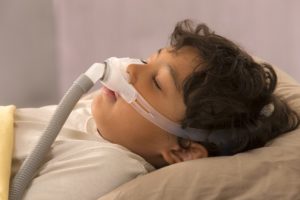 Sleep apnea is the cessation of breathing for ten or more seconds at a time during sleep, and while most patients are only diagnosed with this sleep disorders as adults, children are actually prone to this condition as well. According to the results of the Tucson Children’s Assessment of Sleep Apnea (TuCASA), many young people suffer from undiagnosed sleep apnea. Even more alarming, many of these children, below the age of five, have behavioral, cognitive, and developmental concerns associated with sleep apnea.
Sleep apnea is the cessation of breathing for ten or more seconds at a time during sleep, and while most patients are only diagnosed with this sleep disorders as adults, children are actually prone to this condition as well. According to the results of the Tucson Children’s Assessment of Sleep Apnea (TuCASA), many young people suffer from undiagnosed sleep apnea. Even more alarming, many of these children, below the age of five, have behavioral, cognitive, and developmental concerns associated with sleep apnea.
1 – Kids Can Suffer From Sleep Apnea
The TuCASA study assessed the sleep of 263 children under the age of five. During the initial study, 23 children developed apnea, and of those 23, 21 persisted throughout the initial and follow up age 5 assessments. A larger number, 41 children, had sleep apnea at the start of the study that stopped by the five year assessment.
2 – Kids with Sleep Apnea May Demonstrate Behavioral Problems
Kids who showed signs of sleep apnea were between four and five times more likely to experience cognitive and behavioral concerns. This included difficulty paying attention in class, greater instances of disruptive behavior, and hyperactivity. Lack of sleep can make every aspect of a child’s life more difficult.
3 – Lack of Sleep Impacts Development
Kids with sleep apnea are also four to five times more likely to experience difficulty with social competence and communication. This may contribute to the greater number of kids with apnea who struggled with grades in school. The TuCASA study showed kids with apnea were seven times more likely to be diagnosed with a learning disability and three times more likely to have grades of ‘C’ or lower than kids without sleep apnea.
4 – Treating Childhood Sleep Apnea Improves Whole Life Health
For some kids, the removal of tonsils and/or adenoids fixes the problem, but for kids who do not need to have tonsils or adenoids removed, other sleep apnea treatments may be necessary. Early intervention orthodontics are one option for kids whose apnea is caused by airway obstruction that occurred due to issues with the way teeth fit together or jaw or skull bone development. For others, sleep apnea therapy using oral appliances and/or CPAP systems is used to improve sleep.
Meet Dr. West
At iSleep Solutions, Dr. Pamela West offers patients of all ages comprehensive solutions to improve quantity and quality of sleep for apnea sufferers. Our Las Vegas practice can help you receive an accurate sleep apnea diagnosis, plan for effective treatment, and monitor the success of your sleep apnea therapy. If you want to learn more about sleep apnea, check back regularly with our dental blog. We provide educational information here for patients who are interested in learning more.
